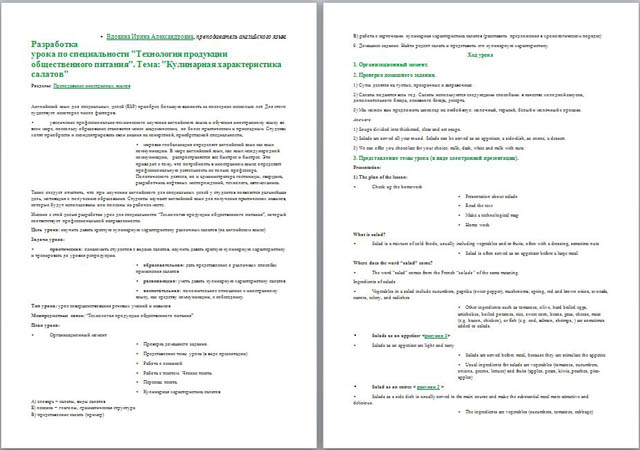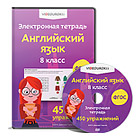Цель урока:
научить давать краткую кулинарную характеристику различных салатов (на английском языке)
Задачи урока:
практическая: ознакомить студентов с видами салатов, научить давать краткую кулинарную характеристику и тренировать до уровня репродукции.
образовательная: дать представление о различных способах применения салатов
развивающая: уметь давать кулинарную характеристику салатов
воспитательная: положительное отношение к иностранному языку, как средству коммуникации, к собеседнику.
Тип урока: урок совершенствования речевых умений и навыков
Межпредметные связи: “Технология продукции общественного питания”
План урока:
Организационный момент
Проверка домашнего задания.
Представление темы урока (в виде презентации)
Работа с лексикой
Работа с текстом. Чтение текста.
Пересказ текста.
Кулинарная характеристика салатов
А) словарь – салаты, виды салатов
Б) лексика – глаголы, грамматическая структура
В) представление салата (пример)
В) работа с карточками: кулинарная характеристика салатов (расставить предложения в хронологическом порядке)
Домашнее задание. Найти рецепт салата и представить его кулинарную характеристику.
Ход урока.
1. Организационный момент.
2. Проверка домашнего задания.
1) Супы делятся на густые, прозрачные и заправочные.
2) Салаты подаются весь год. Салаты используются следующими способами: в качестве холодной закуски, дополнительного блюда, основного блюда, десерта.
3) Мы можем вам предложить шоколад на любой вкус: молочный, горький, белый и молочный с орехами.
Answers:
1) Soups divided into thickened, clear and set soups.
2) Salads are served all year round. Salads can be served as an appetizer, a side-dish, an entree, a dessert.
3) We can offer you chocolate for your choice: milk, dark, white and milk with nuts.
3. Представление темы урока (в виде электронной презентации).
Presentation:
1) The plan of the lesson:
Check up the homework
Presentation about salads
Read the text
Make a technological map
Home work
What is salad?
Salad is a mixture of cold foods, usually including vegetables and/or fruits, often with a dressing, sometime nuts
Salad is often served as an appetizer before a large meal.
Where does the word “salad” come?
The word "salad" comes from the French “salade” of the same meaning.
Ingredients of salads
Vegetables in a salad include cucumbers, paprika (sweet pepper), mushrooms; spring, red and brown onion, avocado, carrots, celery, and radishes.

Other ingredients such as tomatoes, olive, hard boiled eggs, artichokes, boiled potatoes, rice, sweet corn, beans, peas, cheese, meat (e. g. bacon, chicken), or fish (e. g. cod, salmon, shrimps, ) are sometimes added to salads.
Salads as an appetizer <рисунок 1>
Salads as an appetizer are light and tasty
Salads are served before meal, because they are stimulate the appetite
Usual ingredients for salads are vegetables (tomatoes, cucumbers, onions, greens, lettuce) and fruits (apples, pears, kiwis, peaches, pine-apples)
Salad as an entree < рисунок 2 >
Salads as a side dish is usually served to the main course and make the substantial meal more attractive and delicious.
The ingredients are vegetables (cucumbers, tomatoes, cabbage)
Salad as a side-dish <рисунок 3 >
Entree salads may contain chicken, either grilled or fried, on top of the salad, or seafood (shrimps, mussels)
Examples : Caesar salad, Greek salad and Michigan salad
Salad as a dessert <рисунок 4 >
Salads as a desserts are very tasty. Usually these are fruit salads for different tastes.
Ingredients for the fruit salads are quite different: fruits (pine-apple, apples, pears, peaces) and berries (strawberry, grapes, bilberry, cloudberry)
Guess what are the salads? (Догадайтесь, в каком качестве используются салаты?) < рисунок 5>
Dressing (Заправки) <рисунок 6>:
Traditional dressing for the salads is mayonnaise. This is the mixture of vegetable oil, egg yolk, vinegar and seasonings.
French dressing is the mixture of oil, vinegar and seasonings.
Sometimes salads dress with sunflower oil, olive oil.
4. Работа с текстом.
Salads.
Salads are served all year round but they are popular during summer when they are served as an alternative to hot vegetables. Dressings of a salad should usually be done just prior to serving.
The term salad originally referred to the green leaves and stalks of plants that could be eaten uncooked. Salad is any cold dish consisting of meat, poultry, fish, fruits and vegetables.
They may be on the menu in the following ways:
As an appetizer – salad can be served as an appetizer or entree before the main course. It should be light and stimulate the appetite. Suitable types are seafood cocktails, fruit cocktails, smoked salmon salad and avocado cocktails.
As a side-dish- examples include green (mix) salad and cabbage salad.
As the main course – salad can form the basis of the main course. It is usually a combination of cold meat, fish or poultry served with a variety of vegetables, fruits or dairy products.
As a dessert – fruit salad is a popular dessert. It is made by different fruit (melon salad, tropical fruit, berry salad).
When making a salad keep in mind:
When selecting fruit and vegetables, choose only crisp, fresh pieces.
Any ingredients, which has been washed, should be drained well or dried with a clear cloth.
In general, do not dress the salad until just before serving time.
Keep the arrangement of the salad simple.
If using pasta, care should be taken to ensure that it is not overcooked.
Salads must be served on cold plates and kept in a cold place.
Lettuce is the basic ingredients in salad making. It may be finely shredded or it may be used as whole leaves in the bowl or platter. Lettuce, along with other greens, must be washed in a cold water. After washing, the lettuce should be drained or dried with a cloth. The lettuce is then ready for immediate use or can be packed in plastic bags and shorted in fridge.
Other popular salad ingredients are celery, cucumber, tomato, mushrooms, carrots, radishes, onions, spring onions, beetroot, potatoes, cabbage, olives, rice and fruit.
Salad dressings are used with most salads. The two main types of dressings are French dressings and mayonnaise.
French dressing are mixture of oil, vinegar and seasonings. These ingredients do not mix well and dressing must be shaken before use. Suitable oils are olive, peanut and corn. The vinegar used may be cider vinegar.
Весь материал - в документе.

 Получите свидетельство
Получите свидетельство Вход
Вход












 Разработка урока по английскому языку на тему "Кулинарная характеристика салатов" (для специальности: Технология продукции общественного питания) (93 КB)
Разработка урока по английскому языку на тему "Кулинарная характеристика салатов" (для специальности: Технология продукции общественного питания) (93 КB)
 0
0 1154
1154 137
137 Нравится
0
Нравится
0


